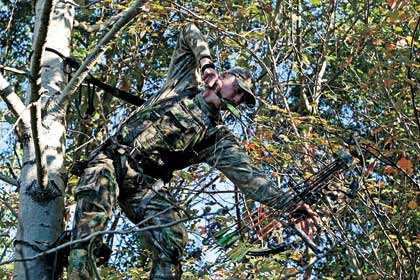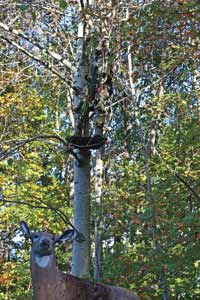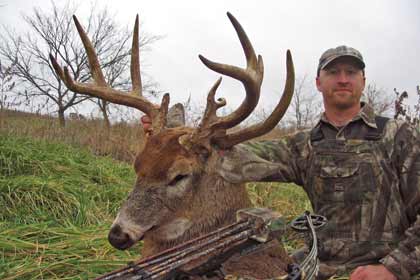November 04, 2010
The only guarantee on guaranteed close-range shots is that they are never guaranteed.

Advertisement
For consistent accuracy when shooting at steep angles, bend at the waist to maintain proper shoulder and upper-body alignment. |
Advertisement
Ultra-close shots, say 15 yards and under, seem so easy, bowhunters often take them for granted. How can anyone possibly miss a deer that close? Well, anyone with a couple of years of bowhunting under his belt has probably done it. The fact is, ultra-close shots may be the hardest of all -- and they're the hardest to swallow when missed. Here are pointers to make sure it doesn't happen to you.
TARGET ASPECT
The last whitetail I hit and did not recover was standing 11 yards from my stand. I clearly saw the arrow strike (that in itself indicates poor follow-through, since I normally wouldn't see arrow impact on shots inside 20 yards). The arrow hit low, right behind the shoulder, and passed through the deer. With bright blood coating the arrow from nock to broadhead, I was confident of a vital hit and quick recovery. I was wrong.
How could a seemingly well-placed arrow not connect with the vitals? Clearly, I wasn't thinking enough about target aspect, and I had not corrected my aimpoint adequately for the steep downward angle presented by the deer so close to my stand.
I should have known better. As a former jet pilot flying an F/A-18 Hornet for the U.S. Navy, I lived and breathed target aspect. Every air-to-air mission briefing included an in-depth discussion of target aspect. Yet, on that deer, this escaped me. Maybe I lost focus because the deer couldn't shoot back. Regardless, I now dwell on the importance of target aspect, especially on close-range deer.
Most shot-placement discussions center on the basics: broadside, head on, tail on, quartering toward and away. Those are important, but on close-range shots from stands, two more aspects come into play: vertical aspect, and the dy-namic nature of aspect.
To examine these concepts for yourself, set a couple of average-sized phone books on end on the floor, six to eight inches apart. These represent the left and right lungs of a deer. As you can see, on some close-range shots, depending on the angle, these "lungs" look a lot like two side-by-side skinny rectangles with a gap in the middle. With the goal of shooting through both books, circle around and watch your opportunity come and go as you change aspect.
Quickly you will recognize that vertical aspect transforms the large, vitals-area target on a broadside deer into a thin sliver of target on a deer closer to your stand. Even more critically, as the range decreases, you will reach a point where you cannot make a double-lung shot at all. Com-bine this with the fact that a high entry hole often leaves a poor blood trail, and you may change your mindset about the efficiency -- even the ethics -- of shooting at deer near or under your stand.
As you circle the phonebooks, notice the dynamic nature of aspect. It changes rapidly -- as it does on stand. Even if walking a straight path, a deer at 10 or 12 yards can present a completely different aspect in a couple of steps. If you pick your spot before drawing, you might be aiming at the wrong place by the time you release. You must constantly analyze shot angle as the situation unfolds.
When I flew fighter aircraft, we first practiced these concepts with choreographed flight routines showing sight picture, angle, and target aspect. We called them "canned setups" because they were the same every time. We then proceeded to dynamic, unpredictable engagements and eventually to all-out dogfights, all to hone our abilities to instantly recognize and act upon impending shot opportunities.

The biggest reason for missed shots inside 15 yards may be lack of short-range practice. Sure, you can shoot quarter-sized groups on a target on level ground, but can you do it while aiming sharply downward from a treestand -- at a living animal? You'd better practice this shot religiously. |
Can you practice this? Sure. Frequently, a partner and I team up to do just that. The shooter climbs into a treestand while the partner randomly repositions a 3-D target after every shot. I especially like doing this in a setting that closely resembles my hunting conditions. Target aspect can look a lot different in a patch of hardwoods than on a field edge or in dense conifers. This kind of practice is invaluable in learning to gauge target aspect -- and make difficult close-range shots.
PERFECT FORM
While dynamic practice is crucial, never overlook form practice. I think the biggest reason for missed shots inside 15 yards is lack of short-range practice. Okay, you're thinking: "I can shoot quarter-sized groups from there -- I don't need to practice. I just mess up my vanes and shoot the nocks off my arrows."
If breaking arrows is your concern, create multiple aimpoints. You'll never shoot groups on a live target, so why do that in practice? Use a Sharpie marker to draw various aimpoints on your 3-D target. Or, as I do, raid your preschooler's sticker books. My favorite practice is shooting off Shrek's ears. While it might stroke your ego to arc arrows into tight groups at 50 yards, it's more important to practice so you'll never miss slam-dunk, close-range shots.
And just because you can shoot tight groups on level ground doesn't mean you can do it from a treestand. Many bowhunters neglect practicing steep, short-range shots for a reason other than broken arrows -- it's hard. Shooting 10-yard shots from a 20-foot stand is uncomfortable and physically demanding.
It also is hard to repeat, and that's why practice is so critical. Most archers can easily translate the results of practice in standing, kneeling, and sitting positions into similar positions in the field because the basic core body and arm positions are the same and easy to duplicate.
Repeating the form required to make close shots from elevated stands is more of a challenge. The major error most hunters make is to aim with only the bow arm and not the entire upper body. This error results in a terrible misalignment of the bow shoulder. To achieve good treestand form, focus on keeping your bow shoulder in the same position relative to the body as it is when you're shooting on the level. Do not simply lower your bow arm to aim downward at a deer; rather, bend at the waist so your entire upper body maintains the same alignment as it does on the level. It takes practice to get the feel of this stance and to build the core muscles needed for consistency.
It also takes practice to feel safe. Bending at the waist places your center of gravity close to the edge of the stand, and you can get comfortable with that precarious feeling only through practice -- and with the support of a good full-body safety harness. Never hunt or practice from a raised platform without a harness. Through practice, you learn to trust yourself, your stand, and your safety gear to shoot with pinpoint accuracy while aiming just above the toe of your boot.

As a jet pilot, I had extensive training in gauging aspect, and as a bowhunter, I diligently practice close-range shooting. Combining those skills, I have learned to "aim small," which has yielded good success in bowhunting. A pinpoint shot at less than 20 yards on this double-beamed buck produced a short blood trail. |
MIND GAMES
The psychology of a short shot is uniquely challenging. It is harder to stay focused and to make your normal shot and follow-through when you are intensely aware of an animal's presence. Seeing whiskers, eyelashes, veins, and the breathing-in-duced movement of the rib cage at 10 yards is enough to divert anyone's attention. The excitement of having an animal right there in your space can be overwhelming, especially when you often struggle just to glimpse a deer.
With an animal so close, it seems impossible not to make a perfect shot, and you must spurn the urge to lapse into caveman mode: "Big game close. No can miss. Sling sharp stick now." If you become mesmerized and try to take in the whole scene -- the game movements, the shot, the arrow impact -- you are guaranteed to see only rapid game movements and a dry arrow sticking in the dirt. Your eyes and mind should remain focused as if you're making a 40-yard shot in a strong crosswind.
In the movie "The Patriot," a great dialog takes place between the lead character and two of his young sons just before they are thrust into battle for the first time.
"What have I always told you boys about shooting?" the father asks.
In unison they respond, "Aim small, miss small."
Keep that concept in mind. Inside of 15 yards, aim small, score big.
The author is a retired U.S. Navy fighter pilot. He makes his home in Glastonbury, Connecticut.
